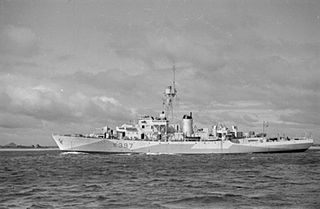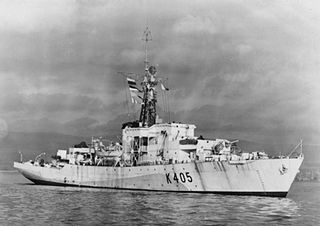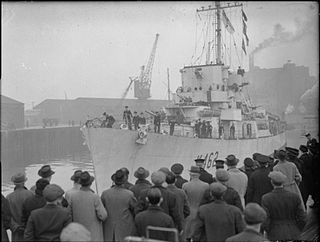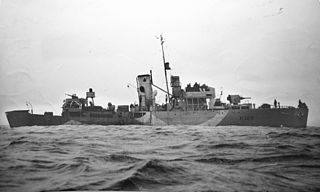
The Cruel Sea is a 1951 novel by Nicholas Monsarrat. It follows the lives of a group of Royal Navy sailors fighting the Battle of the Atlantic during the Second World War. It contains seven chapters, each describing a year during the war.
HMS Audacity was a British escort carrier of the Second World War and the first of her kind to serve in the Royal Navy. She was originally the German merchant ship Hannover, which the British captured in the West Indies in March 1940 and renamed Sinbad, then Empire Audacity. She was converted and commissioned as HMS Empire Audacity, then as HMS Audacity. She was torpedoed and sunk by a German U-boat in late 1941.

The Castle-class corvette was an ocean going convoy escort developed by the United Kingdom during the Second World War. It was the follow-on to the Flower-class corvette, and designed to be built in shipyards that were producing the Flowers. The Castle-class was a general improvement over the smaller Flowers which were designed for coastal rather than open ocean use.

HMS Kenilworth Castle was a Castle-class corvette of the Royal Navy.

HMS Launceston Castle (K397) was a Castle-class corvette of the United Kingdom's Royal Navy, named after Launceston Castle in Cornwall. The ship was constructed during the Second World War and saw service primarily as a convoy escort.
HMS Pevensey Castle was a Castle-class corvette of the United Kingdom's Royal Navy. The ship was constructed during World War II and saw service during the war as a convoy escort. Following the war, the ship was converted into a weather ship and remained as such until being withdrawn from service in 1981 and scrapped in 1982.

The River class was a class of 151 frigates launched between 1941 and 1944 for use as anti-submarine convoy escorts in the North Atlantic. The majority served with the Royal Navy (RN) and Royal Canadian Navy (RCN), with some serving in the other Allied navies: the Royal Australian Navy (RAN), the Free French Navy (FFN), the Royal Netherlands Navy and, post-war, the South African Navy (SAN).

HMS Alnwick Castle was one of 44 Castle-class corvettes built for the Royal Navy during the Second World War. She was named after Alnwick Castle in Northumberland. Completed in late 1944, the ship served as a convoy escort until the end of the war, helping to sink one German submarine. The corvette was placed in reserve after the war and was sold for scrap in 1958.

HMS Hurst Castle (K416) was one of 44 Castle-class corvettes built for the Royal Navy during World War II. Completed in June 1944, she began escorting convoys in August and was sunk by a German U-boat the following month.

The Cruel Sea is a 1953 British war film starring Jack Hawkins, Donald Sinden, Denholm Elliott, Stanley Baker, Liam Redmond, Virginia McKenna and Moira Lister. Made by Ealing Studios seven years after the end of the Second World War, it was directed by Charles Frend and produced by Leslie Norman.

Denys Arthur Rayner DSC & Bar, VRD, RNVR was a Royal Navy officer who fought throughout the Battle of the Atlantic. After intensive war service at sea, Rayner became a writer, a farmer, and a successful designer and builder of small sailing craft - his first being the Westcoaster; his most successful being the glass fibre gunter or Bermudian rigged twin keel Westerly 22 from which evolved similar "small ships" able to cross oceans while respecting the expectations, in terms of comfort, safety and cost, of a burgeoning family market keen to get to sea. Before his death in 1967, Rayner had founded, and via his pioneering GRP designs, secured the future expansion of Westerly Marine Construction Ltd - up until the late 1980s, one of Britain's most successful yacht builders.

HMS Affleck was a Captain-class frigate which served during World War II. The ship was named after Sir Edmund Affleck, commander of HMS Bedford at the Moonlight Battle in 1780 during the American Revolutionary War.

HMCS Kenogami was a Royal Canadian Navy Flower-class corvette that served during the Second World War. The corvette served primarily in convoy escort duties during the Battle of the Atlantic. Following the war, the ship was sold for scrap and broken up.
HMS Capel was a Captain-class frigate, built in the United States as a Evarts-class destroyer escort, and transferred to the Royal Navy under the terms of Lend-Lease, which served in World War II.
German submarine U-1200 was a Type VIIC U-boat of Nazi Germany's Kriegsmarine which saw service during the Second World War.
HMS Nyasaland (K587) was a Colony-class frigate of the United Kingdom that served during World War II. She originally was ordered by the United States Navy as the Tacoma-class patrol frigateUSS Hoste (PF-83) and was transferred to the Royal Navy prior to completion.
HMS Papua (K588) was a Colony-class frigate of the United Kingdom that served during World War II. She originally was ordered by the United States Navy as the Tacoma-class patrol frigateUSS Howett (PF-84) and was transferred to the Royal Navy prior to completion.

HMS Viscount was a V-class destroyer of the British Royal Navy that saw service in the final months of World War I and in World War II.
HMS Coreopsis was a Flower-class corvette, built for the Royal Navy during the Second World War which served in the Battle of the Atlantic. In 1943, she was transferred to the Royal Hellenic Navy as RHNS Kriezis and participated in the 1944 Invasion of Normandy. Shortly before she was scrapped, she took part in the British war film, The Cruel Sea.











